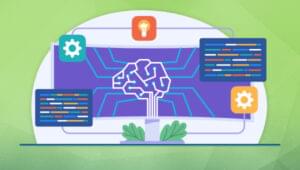Open Source Trends to Look for In 2024

Key Takeaways
- Widespread adoption of AI and machine learning tools in the open-source community is expected to continue in 2024, despite ongoing legal and ethical debates around intellectual property rights and licensing issues.
- There will be an increased focus on security within the open-source community, with the aim of finding ways to better maintain popular projects and ensure the long-term commitment of open-source maintainers.
- Corporate support for the open-source community is predicted to grow, with more initiatives and sponsorships aimed at supporting open-source creators, such as GitHub’s Accelerator program and Codacy’s Pioneers program.
- The proliferation of Open Source Program Offices (OSPOs) within companies is expected to continue in 2024 and beyond, as they help ensure more efficient and less risky open-source strategies and protocols.
According to Open Logic’s 2023 Open Source Report, 80% of polled companies said their use of open source over the previous year had increased. As the corporate adoption of open source continues to increase, the space continues to grow and thrive, thanks to its large and dedicated community.
As always, new technologies and best practices in open-source software (OSS) continue to emerge and lead the community down new and exciting paths. Here’s a preview of some trends you can expect the open-source ecosystem to focus more on in 2024.
We created this article in partnership with Codacy. Thank you for supporting the partners who make SitePoint possible.
Widespread Adoption of Artificial Intelligence and Machine Learning
The software development community is on board with artificial intelligence (AI) and machine learning (ML) in 2023. A recent GitHub survey showed that 92% of developers use AI-powered coding assistants.
AI and ML tools don’t just assist coders; they’re being used to aid any task requiring learning, problem-solving, and decision-making.
AI adoption in open source is also rapidly growing and has gone completely mainstream. We’ve already seen Google using AI for image and speech recognition tasks. Facebook has also unveiled an open-source machine-learning library called PyTorch.
While AI adoption and use is one part of the story, the other is the legal and ethical issues that this adoption has brought into the spotlight. Open-source software is at the forefront of many of these debates, because most of the coding data that ML models train on are open-source projects.
This learning method brings into question intellectual property rights and licensing issues. Should the OSS creators who wrote the code used to train AI be compensated? Should it even be legal to train these tools on the work of others?
We’ve seen that AI-powered image creators and writing tools have successfully managed to avoid copyright issues. However, one class action suit was filed against GitHub, alleging their CoPilot AI tool violates numerous open-source licenses.
While the chances of resolving these issues of legality and ethics regarding the use of AI technology will take a long time to resolve, it’s hard to believe that these concerns will be able to slow the widespread interest in and adoption of AI and ML tools in open source and otherwise.
A Greater Focus on Security
According to the Synopsys 2023 Open Source Security and Risks Analysis (OSSRA) Report, 87% of the 1,700+ codebases they scanned for the report included security and operational risk assessments. The report found that 89% of the codebases contained open source code that was over four years out of date, and 91% contained components with no new development in at least two years.
With the Log4j library zero-day critical vulnerability event still fresh in the minds of all open-source creators, the OSS community is expected to continue stressing the importance of security and privacy best practices in 2024.
Open source is everywhere. The 2022 OSSRA report showed that 97% of software contains some open source. Open source made up 78% of all code reviewed for the report. More importantly, 81% of the codebases that include open-source code had at least one security vulnerability and an average of five high-risk vulnerabilities.
Open source is ubiquitous and permeates nearly every critical technology we depend on, making proper security and privacy even more vital. When networks worldwide use the same open-source code, one vulnerability could collapse innumerable systems across the globe.
However, open source’s greatest asset is also its most significant obstacle. Why invest in something that’s completely free?
According to a 2023 study by Tidelift, 60% of open-source maintainers are “unpaid hobbyists.” Just 13% describe themselves as professional maintainers who earn their living from this work.
The study also found that more than half of the maintainers polled needed to be made aware of recent security initiatives like OSSF scorecards, supply-chain levels for software architects (SLSA), and the NIST Secure Software Development Framework (SSDF).
For security and workability, a priority for the open-source community in 2024 and beyond must be finding ways to maintain popular projects better — namely, paying open-source maintainers well enough to commit to this type of work long-term.
Increased Corporate Support
Technology companies (both large and small) are becoming increasingly aware of the importance of the open-source community on their entire ecosystem. This recognition of open source’s importance is already leading to increased initiatives and sponsorships aimed at supporting open-source creators.
One of the most notable ones is GitHub’s Accelerator program, launched in April of 2023. The 10-week program provided selected open-source projects with funding and guidance.
Lisbon-based code quality platform Codacy is doing something very similar. They announced a fellowship program for open-source creators called Pioneers. Chosen projects will receive a monthly stipend for an entire year, free tooling, promotion for their projects, and mentorship for a star-studded cast of open-source experts, including Vue.js framework creator Evan You.
Applications for the Pioneers program are open until the end of September, and fellows will be selected and announced in mid-October.
Another recent example of open-source sponsorships is the Rust Foundation’s current project, which offered grants to maintainers working with that programming language, which has a very active open-source ecosystem and community.
More Companies with Open Source Program Offices
Open Source Program Offices (OSPOs) are cross-functional teams within companies that are responsible for how their companies use open source. They create strategies and policies to ensure their company’s open-source strategies and protocols are more efficient and less risky.
The further proliferation of OSPOs should be expected in 2024 and beyond. According to GitHub’s 2022 Octoverse report, 30% of Fortune 100 companies have OSPOs. Research by the Linux Foundation also found that while OSPO adoption is still most prevalent in technology companies, we’re seeing increased adoption in other industries, like education and the public sector.
OSPOs can go a long way toward helping developers, technical staff, procurement, and legal teams select and implement the right open-source tools. An OSPO can also be very helpful in educating staff and creating a culture of transparency and accountability when building an internal tool stack.
In 2024, don’t be surprised if more companies create roles and titles like Chief Open Source Officer to head OSPOs and work with Chief Technology Officers to create more efficient, secure, and sustainable open source policies for their companies.
Frequently Asked Questions (FAQs) about Open Source Trends
What are the latest trends in open source software?
The open source software landscape is constantly evolving. One of the latest trends is the increased adoption of open source software by businesses. Companies are increasingly recognizing the benefits of open source software, such as cost-effectiveness, flexibility, and the ability to customize the software to meet their specific needs. Another trend is the growing popularity of open source software in the cloud. As more businesses move their operations to the cloud, they are turning to open source solutions to help manage their cloud-based systems. Additionally, there is a growing trend towards the use of open source software in the development of artificial intelligence and machine learning technologies.
How is open source software impacting the tech industry?
Open source software is having a profound impact on the tech industry. It is driving innovation by allowing developers to collaborate and share ideas, leading to the creation of new technologies and solutions. Open source software is also helping to democratize the tech industry by making high-quality software accessible to everyone, regardless of their financial resources. Furthermore, it is changing the business models of tech companies, as they are now focusing more on providing services and support for open source software, rather than selling proprietary software.
What are the benefits of using open source software?
There are numerous benefits to using open source software. One of the main advantages is cost-effectiveness. Open source software is typically free to use, which can save businesses a significant amount of money. Another benefit is flexibility. With open source software, users have the freedom to modify and customize the software to suit their specific needs. Additionally, open source software is often more secure than proprietary software, as it is regularly reviewed and improved by a community of developers.
What are the potential challenges of using open source software?
While open source software offers many benefits, it also comes with potential challenges. One of the main challenges is the lack of customer support. Unlike proprietary software, open source software does not come with a dedicated customer support team. This means that users may need to rely on community forums or hire external consultants for help. Another challenge is that open source software may not be as user-friendly as proprietary software, which can make it difficult for non-technical users to use.
How can I contribute to open source projects?
There are many ways to contribute to open source projects. One of the most common ways is by contributing code. If you’re a developer, you can contribute by fixing bugs, adding new features, or improving the software’s performance. However, you don’t need to be a developer to contribute. You can also contribute by reporting bugs, writing documentation, designing user interfaces, or helping with marketing and outreach efforts. To get started, you can find an open source project that interests you, and reach out to the project maintainers to see how you can help.
What is the future of open source software?
The future of open source software looks promising. As more businesses recognize the benefits of open source software, its adoption is likely to continue to grow. Additionally, as more people learn about open source and start contributing to open source projects, the quality and diversity of open source software is likely to improve. Furthermore, with the rise of technologies like artificial intelligence and machine learning, there are likely to be many exciting new opportunities for open source software in the future.
How does open source software compare to proprietary software?
Open source software and proprietary software each have their own strengths and weaknesses. Open source software is typically more flexible and cost-effective than proprietary software. It allows users to modify and customize the software to meet their specific needs. However, it may not be as user-friendly as proprietary software, and it does not come with dedicated customer support. On the other hand, proprietary software often comes with customer support and may be more user-friendly, but it is usually more expensive and less flexible than open source software.
What is the role of open source software in cloud computing?
Open source software plays a crucial role in cloud computing. Many of the technologies that power the cloud, such as the Linux operating system, the Apache web server, and the MySQL database, are open source. Open source software allows cloud providers to customize their services to meet the specific needs of their customers. It also helps to ensure that the cloud is secure and reliable, as the open source community regularly reviews and improves the software.
How does open source software support innovation?
Open source software supports innovation by fostering collaboration and sharing of ideas. Because the source code is freely available, developers can build upon each other’s work, leading to the creation of new technologies and solutions. Open source software also encourages experimentation, as developers are free to modify the software and try out new ideas without the fear of infringing on proprietary rights.
What is the impact of open source software on artificial intelligence and machine learning?
Open source software is playing a key role in the development of artificial intelligence and machine learning technologies. Many of the most popular AI and machine learning frameworks, such as TensorFlow and PyTorch, are open source. These frameworks allow researchers and developers to collaborate and share their work, accelerating the pace of innovation in the field. Furthermore, by making these tools freely available, open source software is helping to democratize AI and machine learning, making these technologies accessible to a wider range of people and organizations.
David is a professional writer with over a decade of experience working with technology companies, SaaS/B2B startups in particular.








